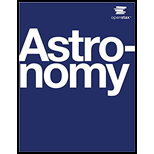
Astronomy
1st Edition
ISBN: 9781938168284
Author: Andrew Fraknoi; David Morrison; Sidney C. Wolff
Publisher: OpenStax
expand_more
expand_more
format_list_bulleted
Concept explainers
Textbook Question
Chapter 30, Problem 21E
Does all life on Earth require sunshine?
Expert Solution & Answer
Want to see the full answer?
Check out a sample textbook solution
Students have asked these similar questions
Hi! I need help with these calculations for part i and part k for a physics Diffraction Lab. We used a slit width 0.4 mm to measure our pattern.
Examine the data and % error values in Data Table 3 where the angular displacement of the simple pendulum decreased but the mass of the pendulum bob and the length of the pendulum remained constant. Describe whether or not your data shows that the period of the pendulum depends on the angular displacement of the pendulum bob, to within a reasonable percent error.
In addition to the anyalysis of the graph, show mathematically that the slope of that line is 2π/√g . Using the slope of your line calculate the value of g and compare it to 9.8.
Chapter 30 Solutions
Astronomy
Ch. 30 - What is the Copernican principle? Make a list of...Ch. 30 - Where in the solar system (and beyond) have...Ch. 30 - Give a short history of the atoms that are now in...Ch. 30 - What is a biomarker? Give some possible examples...Ch. 30 - Why are Mars and Europa the top targets for the...Ch. 30 - Why is traveling between the stars (by creatures...Ch. 30 - What are the advantages to using radio waves for...Ch. 30 - What is the “cosmic haystack problem”? List as...Ch. 30 - What is a habitable zone?Ch. 30 - Why is the simultaneous detection of methane and...
Ch. 30 - What are two characteristic properties of life...Ch. 30 - What are the three requirements that scientists...Ch. 30 - Can you name five environmental conditions that,...Ch. 30 - Would a human have been possible during the first...Ch. 30 - If we do find life on Mars, what might be some...Ch. 30 - What kind of evidence do you think would convince...Ch. 30 - What are some reasons that more advanced...Ch. 30 - What are some answers to the Fermi paradox? Can...Ch. 30 - Why is there so little evidence of Earth’s...Ch. 30 - Why was the development of photosynthesis a major...Ch. 30 - Does all life on Earth require sunshine?Ch. 30 - Why is life unlikely to be found on the surface of...Ch. 30 - In this chapter, we identify these characteristic...Ch. 30 - Given that no sunlight can penetrate Europa’s ice...Ch. 30 - Why is Saturn’s moon Enceladus such an exciting...Ch. 30 - In addition to an atmosphere dominated by...Ch. 30 - How can a planet’s atmosphere affect the width of...Ch. 30 - Why are we limited to finding life on planets...Ch. 30 - Suppose astronomers discover a radio message from...Ch. 30 - The light a planet receives from the Sun (per...Ch. 30 - Think of our Milky Way Galaxy as a flat disk of...
Additional Science Textbook Solutions
Find more solutions based on key concepts
a. How can aspirin be synthesized from benzene? b. Ibuprofen is the active ingredient in pain relievers such as...
Organic Chemistry (8th Edition)
WHAT IF? As a cell begins the process of dividing, its chromosomes become shorter, thicker, and individually vi...
Campbell Biology in Focus (2nd Edition)
Distinguish between microevolution, speciation, and macroevolution.
Campbell Essential Biology (7th Edition)
Choose the best answer to each of the following. Explain your reasoning. One week after full moon, the Moons ph...
Cosmic Perspective Fundamentals
Using the South Atlantic as an example, label the beginning of the normal polarity period C that began 2 millio...
Applications and Investigations in Earth Science (9th Edition)
In Figure 12.14, why do the nuclei resulting from experiment 2 contain different amounts of DNA?
Campbell Biology (11th Edition)
Knowledge Booster
Learn more about
Need a deep-dive on the concept behind this application? Look no further. Learn more about this topic, physics and related others by exploring similar questions and additional content below.Similar questions
- An object is placed 24.1 cm to the left of a diverging lens (f = -6.51 cm). A concave mirror (f= 14.8 cm) is placed 30.2 cm to the right of the lens to form an image of the first image formed by the lens. Find the final image distance, measured relative to the mirror. (b) Is the final image real or virtual? (c) Is the final image upright or inverted with respect to the original object?arrow_forwardConcept Simulation 26.4 provides the option of exploring the ray diagram that applies to this problem. The distance between an object and its image formed by a diverging lens is 5.90 cm. The focal length of the lens is -2.60 cm. Find (a) the image distance and (b) the object distance.arrow_forwardPls help ASAParrow_forward
arrow_back_ios
SEE MORE QUESTIONS
arrow_forward_ios
Recommended textbooks for you
 AstronomyPhysicsISBN:9781938168284Author:Andrew Fraknoi; David Morrison; Sidney C. WolffPublisher:OpenStax
AstronomyPhysicsISBN:9781938168284Author:Andrew Fraknoi; David Morrison; Sidney C. WolffPublisher:OpenStax
 An Introduction to Physical SciencePhysicsISBN:9781305079137Author:James Shipman, Jerry D. Wilson, Charles A. Higgins, Omar TorresPublisher:Cengage Learning
An Introduction to Physical SciencePhysicsISBN:9781305079137Author:James Shipman, Jerry D. Wilson, Charles A. Higgins, Omar TorresPublisher:Cengage Learning Foundations of Astronomy (MindTap Course List)PhysicsISBN:9781337399920Author:Michael A. Seeds, Dana BackmanPublisher:Cengage Learning
Foundations of Astronomy (MindTap Course List)PhysicsISBN:9781337399920Author:Michael A. Seeds, Dana BackmanPublisher:Cengage Learning Stars and Galaxies (MindTap Course List)PhysicsISBN:9781337399944Author:Michael A. SeedsPublisher:Cengage Learning
Stars and Galaxies (MindTap Course List)PhysicsISBN:9781337399944Author:Michael A. SeedsPublisher:Cengage Learning

Astronomy
Physics
ISBN:9781938168284
Author:Andrew Fraknoi; David Morrison; Sidney C. Wolff
Publisher:OpenStax


An Introduction to Physical Science
Physics
ISBN:9781305079137
Author:James Shipman, Jerry D. Wilson, Charles A. Higgins, Omar Torres
Publisher:Cengage Learning

Foundations of Astronomy (MindTap Course List)
Physics
ISBN:9781337399920
Author:Michael A. Seeds, Dana Backman
Publisher:Cengage Learning

Stars and Galaxies (MindTap Course List)
Physics
ISBN:9781337399944
Author:Michael A. Seeds
Publisher:Cengage Learning

General Relativity: The Curvature of Spacetime; Author: Professor Dave Explains;https://www.youtube.com/watch?v=R7V3koyL7Mc;License: Standard YouTube License, CC-BY